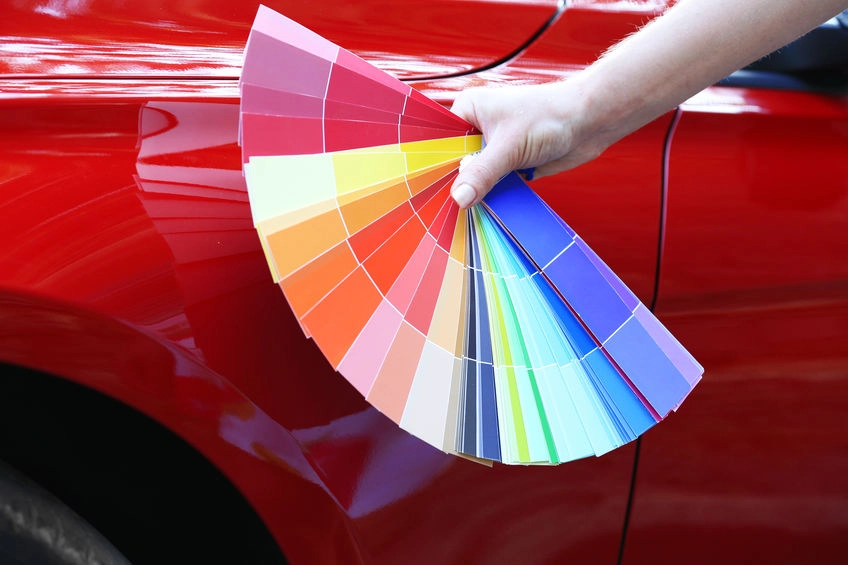What is 2-stage and 3-stage paint process?
There’s some confusion about what these are - so we’ll do our best to settle it once and for all!

Broadly speaking, there are 3 different types of car paint:
- Solid / single stage – which is just paint.
- Pearlescent / mica / metallics that need a lacquer - making them a 2 stage process (but not 2 stage paint).
- 3 stage paint – 2 parts of paint (coloured base coat then pearlescent top coat) needed to achieve the colour; then lacquer needed to achieve the finish.
There are also 3 different types of car paint (solid colour, pearlescent and metallic). If you’re wondering how to remove scratches from metallic car paint and the rest, the long and the short of it is that certain paint finishes have certain requirements.
Single stage
This paint is a solid colour with no enhancements - that is, it’s not metallic or pearlescent, therefore it’s known to have only a single component. It’s known as single stage gloss or 1k direct gloss.
- Paint layers
- Lacquer (optional)
You might need to apply more than one coat of paint to build up to the correct original colour of your car. Too little paint can look too light, too much paint or new paint on undamaged paintwork could look too dark. solid colours don’t strictly require a lacquer although PaintNuts recommends a clear coat lacquer to enhance, seal and protect the paint and repair.
2-stage
2 stage paints is generally metallic, mica and some pearlescent colours that require a gloss lacquer to bring out the full effect of the paint.
The sought-after shine comes from a small amount of metallic or pearlescent pigments mixed into the paint that catch and reflect light. Around 65% of all car paints are a 2-stage metallic or mica pearlescent paint.
- Paint
- Lacquer
1. Paint
Apply metallic paint onto primer or direct to bodywork depending on the damage.
Metallic car paint contains flecks or particles of metal. These are so small that individual particles can’t be seen with the naked eye - but they’re square. They need to lie in alignment so that when the light bounces off them, the car paint achieves the intended uniform shade.
Car paint for metallic and pearlescent finishes, including touch-up paint, includes a ‘flop control’ additive that achieves this. However, the surface of bare metallic paint will still be naturally slightly bumpy, because of the flecks.
2. Lacquer layer
The lacquer protects and enhances the metallic or pearlescent pigments, and brings out the shine as well as sealing and protecting it.
3-stage
Certain types of pearlescent car paint need 3-stages to get the right results (3-stage paint is always used for pearlescent car paint).
It’s 2 parts of paint (the coloured base coat then a pearlescent top coat) needed to achieve the colour; then lacquer needed to achieve the finish.
- Ground coat
- Topcoat
- Lacquer
The number of 3-stage pearlescent paints is increasing all the time car manufacturers release new colours. These modern colours are more vibrant than ever before, and the pearlescent sheen has evolved into a more complex effect.
1. Ground coat
Pearlescent paint has a metallic ground layer that is applied on top of the primer. The shade of this layer is usually much lighter or paler than the finished colour will be.
2. Pearl topcoat (multiple coats)
These pearlescent paint layers are translucent, to allow the metallic ground layer to sparkle through. You will probably need at least 2 layers; some paints will need 3.
Car paint is translucent, which means you can, to an extent, see through it. Additional layers of paint are needed to intensify colour.
3. Lacquer layer
Gloss lacquer enhances the look of all paint effects. It smooths the surface of pearlescents (and metallics) and seals and protects your car paint.
Like touch-up paint pens, it comes in a precision pen, bottle with brush, and aerosol.
How many layers of paint?
It’s not possible to say outright that, for certain, if your particular type of car touch up paint will need 2 or 3 layers of topcoat. It depends on:
- The intensity of your car’s original colour.
- The age of your car.
For example, if it’s a few years old, has done a lot of miles on dirty and salty motorways, and hasn’t been stored in a garage or carport, then your paint might have faded significantly from its original colour.
In this case, while the manufacturer might have applied 3 topcoats, you might only need 2. And there’s no scientific process of knowing - you must work it out by eye.
If you’re using a precision touch-up pen to fix a scratch or paint chip, judging whether it’s 2 or 3 layers isn’t critical because the area you’re covering is so small - it will blend in, regardless.
However, when it comes to larger areas of damage like scuffs or a filler repair, or you’re respraying a whole panel, it’s pretty important.
Ready to order?
Our car touch up paint is precision-measured and mixed to the highest specification. It’s bodyshop quality, durable and easy-to-use to achieve a good result. It’s available as a precision car touch up paint pen, bottle with brush, and car paint aerosol. We also supply it in larger 500ml/1 litre quantities to trade customers.



